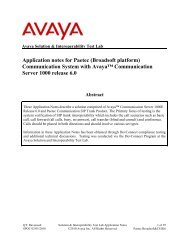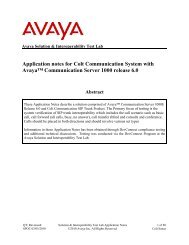Verizon Business SIP Trunking - Michael McNamara
Verizon Business SIP Trunking - Michael McNamara
Verizon Business SIP Trunking - Michael McNamara
Create successful ePaper yourself
Turn your PDF publications into a flip-book with our unique Google optimized e-Paper software.
NN10000-109 December 15, 2009 Revision: 2.0<br />
Deployment Options<br />
There are a number of possible engineering options to consider when deployed <strong>SIP</strong> based<br />
trunking. The two main considerations that affect hardware and patching are redundancy and<br />
Private Networking requirements.<br />
ISP1100 servers are shown in the diagrams below, but COTS and CP-PM servers can be used<br />
as well.<br />
Figure 1 below depicts the simplest deployment model, utilizing one or more Signaling Servers to<br />
provide Telephone Proxy and <strong>SIP</strong> GW capability. The single Node configuration would have TPS<br />
and <strong>SIP</strong> GW applications enabled for all servers in the Node. The engineering rules for coresident<br />
TPS and <strong>SIP</strong> GW would apply. Patching on the Signaling Servers would consist of the<br />
current DEPLIST plus the required patches to support <strong>Verizon</strong> <strong>SIP</strong> <strong>Trunking</strong>. Private Networking<br />
to other Nortel products or Nortel Developer Partner products is not supported due the changes<br />
the <strong>Verizon</strong> specific patches introduce to the <strong>SIP</strong> signaling.<br />
______________________________________________________________________________________________________<br />
7<br />
MG 1000<br />
Figure 1 - Stand-Alone Communication Server and Nortel-<strong>Verizon</strong> <strong>Business</strong> Sip <strong>Trunking</strong>







